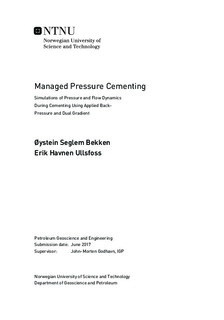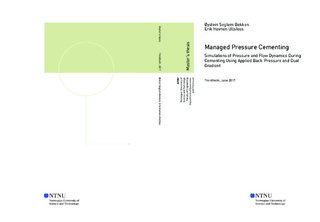| dc.description.abstract | Cement operations in narrow pressure windows can be challenging, due to the increased hydrostatic pressure caused by heavy-weight cement. Through managed pressure control, downhole pressure fluctuations can be controlled, maintaining a relatively constant annulus pressure profile during the entire operation. Managed Pressure Drilling (MPD) has successfully been applied in several wells around the world to accurately control the annular downhole pressure during drilling. In this thesis, the advantages of applying MPD techniques while cementing, commonly known as Managed Pressure Cementing (MPC), are investigated. The flow and pressure dynamics throughout the entire cement operation are described by a simple hydraulic model. A Proportional-Integral (PI) controller is implemented to control the down hole pressure fluctuations. The MPC techniques presented in this thesis include an Applied Back-Pressure (ABP) system and a Dual Gradient (DG) system. In the ABP system, the bottom hole pressure is managed through regulation of a topside choke valve. In the DG system, a subsea pump module is used to manage the bottom hole pressure by altering the riser level. The MPC models are simulated in MATLAB to demonstrate how MPC can improve conventional cement operations. Based on the results, the ABP system was superior to the DG system in compensating for annular downhole pressure fluctuations. The choke regulations in the closed ABP system gave a faster pressure response in the well, compared to the open DG system altering the riser level. However, since the ABP system is constantly in underbalance, the consequence of equipment failure can be severe. Compared to a conventional cement job, MPC provides increased pressure control, allows for higher displacement rates and the cement/spacer to be tailored outside of traditional pressure limits. Hence, successful MPC operations are associated with reduced risk, increased efficiency and improved cement jobs. | |

